 W
WThe Wheeler Shale is a Cambrian (c. 507 Ma) fossil locality world-famous for prolific agnostid and Elrathia kingii trilobite remains and represents a Konzentrat-Lagerstätte. Varied soft bodied organisms are locally preserved, a fauna and preservation style normally associated with the more famous Burgess Shale. As such, the Wheeler Shale also represents a Konservat-Lagerstätten.
 W
WAlalcomenaeus is one of the most widespread and longest-surviving arthropod genera of the Early and Middle Cambrian. Known from over 300 specimens in the Burgess Shale, and the Chengjiang, it bears great similarity to the opabiniids.
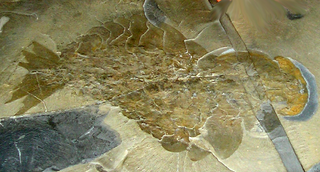 W
WAnomalocaris is an extinct genus of radiodont (anomalocaridid), an order of animals thought to be closely related to ancestral arthropods. The first fossils of Anomalocaris were discovered in the Ogygopsis Shale by Joseph Frederick Whiteaves, with more examples found by Charles Doolittle Walcott in the Burgess Shale. Originally several fossilized parts discovered separately were thought to be three separate creatures, a misapprehension corrected by Harry B. Whittington and Derek Briggs in a 1985 journal article. Anomalocaris is thought to be one of the earliest examples of an apex predator, though others have been found in older Cambrian lagerstätten deposits.
 W
WAsaphiscus is a genus of trilobite that lived in the Cambrian. Its remains have been found in Australia and North America, especially in Utah.
 W
WBathyuriscus is an extinct genus of Cambrian trilobite. It was a nektobenthic predatory carnivore. The genus Bathyuriscus is endemic to the shallow seas that surrounded Laurentia. Its major characteristics are a large forward-reaching glabella, pointed pleurae or pleurae with very short spines, and a medium pygidium with well-impressed furrows. Complete specimens have never reached the size of 7 cm predicted by the largest pygidium found. Bathyuriscus is often found with the free cheeks shed, indicating a moulted exoskeleton. An average specimen will in addition have a furrowed glabella, crescent-shaped eyes, be semi-circular in overall body shape, have 7 to 9 thoracic segments, and a length of about 1.5 inches.
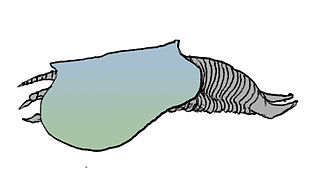 W
WBranchiocaris is a Cambrian organism known from Burgess shale-type localities. 4 specimens of Branchiocaris are known from the Greater Phyllopod bed, where they comprise <0.1% of the community.
 W
WCanadaspis is an extinct genus of Cambrian-aged crustacean or euarthropod, a benthic feeder that moved mainly by walking and possibly used its biramous appendages to stir mud in search of food. The genus has been placed within the subclass Phyllocarida, in the class Malacostraca that includes shrimps and lobsters.
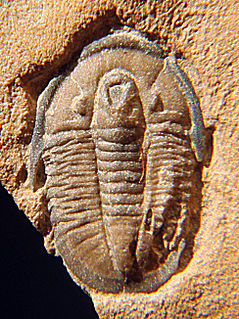 W
WCedaria is a small, rather flat trilobite with an oval outline, a headshield and tailshield of approximately the same size, 7 articulating segments in the middle part of the body and spines at the back edges of the headshield that reach halflength of the body. Cedaria lived during the early part of the Upper Cambrian (Dresbachian), and is especially abundant in the Weeks Formation.
 W
WChancelloria is a genus of early animals known from the Middle Cambrian Burgess Shale, the Comley limestone, the Wheeler Shale, the Bright Angel Shale and elsewhere. It is named after Chancellor Peak. It was first described in 1920 by Charles Doolittle Walcott, who regarded them as one of the most primitive groups of sponges. This appears unlikely, and it is currently placed in the enigmatic group Coeloscleritophora. 178 specimens of Chancelloria are known from the Greater Phyllopod bed, where they comprise 0.34% of the community.
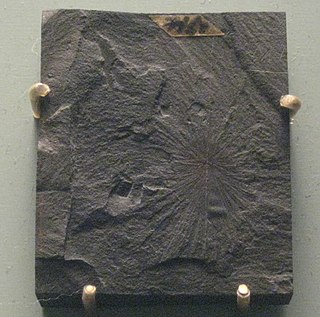 W
WChoia is a genus of extinct demosponge ranging from the Cambrian until the Lower Ordovician periods. Fossils of Choia have been found in the Burgess Shale in British Columbia; the Maotianshan shales of China; the Wheeler Shale in Utah; and the Lower Ordovician Fezouata formation. It was first described in 1920 by Charles Doolittle Walcott.
 W
WCothurnocystis is a genus of small enigmatic echinoderms that lived during the Ordovician. Individual animals had a flat boot-shaped body and a thin rod-shaped appendage that may be a stem, or analogous to a foot or a tail. Fossils of Cothurnocystis species have been found in Nevada, Scotland, Czech Republic, France and Morocco.
 W
WDiagoniella is a genus of sponge known from the Middle Cambrian Burgess Shale. 128 specimens of Diagoniella are known from the Greater Phyllopod bed, where they comprise 0.24% of the community.
 W
WEldonia is an extinct soft-bodied cambroernid animal of unknown affinity, best known from the Fossil Ridge outcrops of the Burgess Shale, particularly in the 'Great Eldonia layer' in the Walcott Quarry. In addition to the 550 collected by Walcott, 224 specimens of Eldonia are known from the Greater Phyllopod bed, where they comprise 0.43% of the community. Species also occur in the Chengjiang biota, and in Upper Ordovician strata of Morocco.
 W
WElrathia is a genus of ptychopariid trilobite species that lived during the Middle Cambrian of Utah, and possibly British Columbia. E. kingii is one of the most common trilobite fossils in the USA locally found in extremely high concentrations within the Wheeler Formation in the U.S. state of Utah. E. kingii has been considered the most recognizable trilobite. Commercial quarries extract E. kingii in prolific numbers, with just one commercial collector estimating 1.5 million specimens extracted in a 20-year career. 1950 specimens of Elrathia are known from the Greater Phyllopod bed, where they comprise 3.7% of the community."...trilobite occupied the exaerobic zone, at the boundary of anoxic and dysoxic bottom waters. E. kingii consistently occur in settings below the oxygen levels required by other contemporaneous epifaunal and infaunal benthic biota and may have derived energy from a food web that existed independently of phototrophic primary productivity. Although other fossil organisms are known to have preferred such environments, E. kingii is the earliest-known inhabitant of them, extending the documented range of the exaerobic ecological strategy into the Cambrian Period."
 W
WEmeraldella is a genus of arthropod known from the Middle Cambrian of North America. The type species E. brocki was described in 1912 from the Burgess Shale. 21 specimens of Emeraldella are known from the Greater Phyllopod bed, where they comprise < 0.1% of the community. A re-study on the species was done in 2012. A second species E. brutoni is known from the Wheeler Shale, which was described in 2011. An additional specimen of E. brutoni was described in 2019, which revealed more of the anatomy.
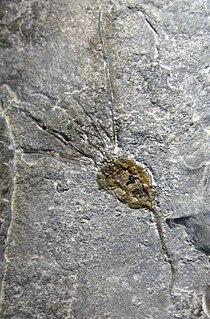 W
WGogia is a genus of primitive eocrinoid blastozoan from the early to middle Cambrian.
Hallucigenia is a genus of Cambrian animal known from articulated fossils in Burgess Shale-type deposits in Canada and China, and from isolated spines around the world. The generic name reflects the type species' unusual appearance and eccentric history of study; when it was erected as a genus, H. sparsa was reconstructed as an enigmatic animal upside down and back to front. Hallucigenia is later recognized as part of lobopodians, a grade of Paleozoic panarthropods where the velvet worms, water bears and arthropods arose.
 W
WIsoxys is a genus of extinct, pelagic bivalved arthropod; the various species may have been roam-swimming predators. It had a pair of large spherical eyes, and two large appendages It is possible that these appendages are homologous to the great appendages of radiodonts and megacheirans.
 W
WKootenia is a genus of trilobites of the family Dorypygidae. 118 specimens of Kootenia are known from the Greater Phyllopod bed, where they comprise 0.22% of the community. Its major characteristics are that of the closely related Olenoides, including medium size, a large glabella, and a medium-sized pygidium, but also a lack of the strong interpleural furrows on the pygidium that Olenoides has.
 W
WLeanchoilia is an megacheiran arthropod known from Cambrian deposits of the Burgess Shale in Canada and the Chengjiang biota of China. It was about 5 centimetres (2.0 in) long and had long, whip-like feelers mounted on frontal arm-like appendages. Its internal organs are occasionally preserved within the substrate in three dimensions.
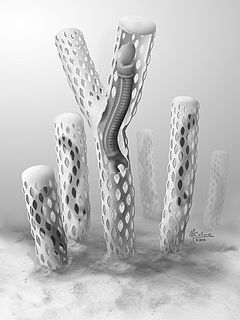 W
WMargaretia is a frondose organism known from the middle Cambrian Burgess shale. Its fronds reached about 10 cm in length and are peppered with a range of length-parallel oval holes. It was originally interpreted as an alcyonarian coral. It was later reclassified as a green alga closely resembling modern Caulerpa by D.F. Satterthwait in her Ph.D. thesis in 1976, a finding supported by Conway Morris and Robison in 1988. More recently, it has been treated as an organic tube, that is used as nest of hemichordate Oesia.
 W
WMarpolia has been interpreted as a cyanobacterium, but also resembles the modern cladophoran green algae. It is known from the Middle Cambrian Burgess shale and Early Cambrian deposits from the Czech Republic. It comprises a dense mass of entangled, twisted filaments. It may have been free-floating or grown on other objects, although there is no evidence of attachment structures. 40 specimens of Marpolia are known from the Greater Phyllopod bed, where they comprise 0.08% of the community.
 W
WNaraoia is a genus of small to average size marine arthropods within the family Naraoiidae, that lived from the early Cambrian to the late Silurian period. The species are characterized by a large alimentary system and sideways oriented antennas.
 W
WOlenoides was a trilobite from the Cambrian period. Its fossils are found well-preserved in the Burgess Shale in Canada. It grew up to 10 cm long.
 W
WOttoia is a stem-group archaeopriapulid worm known from Cambrian fossils. Although priapulid-like worms from various Cambrian deposits are often referred to Ottoia on spurious grounds, the only clear Ottoia macrofossils come from the Burgess Shale of British Columbia, which was deposited 508 million years ago. Microfossils extend the record of Ottoia throughout the Western Canada Sedimentary Basin, from the mid- to late- Cambrian. A few fossil finds are also known from China.
 W
WPelagiellidae is an extinct family of Paleozoic fossil 'snails'. Some material assigned to this taxon represents gastropod molluscs, but some chaeta-bearing specimens first assigned to Pelagiella are perhaps better interpreted as tube-bearing annelid worms.
 W
WPeronopsis is a genus of trilobite restricted to the Middle Cambrian. Its remains have been found in Asia, Australia, Europe, and North America.
 W
WPerspicaris is a fossil arthropod from the Cambrian period. It was 2–3 centimetres (0.8–1.2 in) long and bivalved. The valves, encasing the thorax, were joined together by a dorsal hinge.
 W
WPtychagnostus is a member of the agnostida that lived during the Cambrian period. Ptychagnostidae generally do not exceed one centimetre in length. Their remains are rarely found in empty tubes of the polychaete worm Selkirkia. The genus probably ranged throughout the water column. It has two glabellar lobes, and three pygidial lobes,.
 W
WPtychagnostus atavus is a species of agnostid trilobite. It was originally described by Swedish paleontologist Sven Axel Tullberg as Agnostus atavus in 1880. It is used in biostratigraphy as an index fossil. Its first appearance at the GSSP section in the Wheeler Shale of Utah is defined as the beginning of the Drumian Age of the Miaolingian.
 W
WSelkirkia is a genus of predatory, tubicolous priapulid worms known from the Middle Cambrian Burgess Shale, Ogygopsis Shale and Puncoviscana Formation. 142 specimens of Selkirkia are known from the Greater Phyllopod bed, where they comprise 0.27% of the community. In the Burgess Shale, 20% of the tapering, organic-walled tubes are preserved with the worm inside them, whereas the other 80% are empty. Whilst alive, the tubes were probably vertical, whereas trilobite-occupied tubes are horizontal.
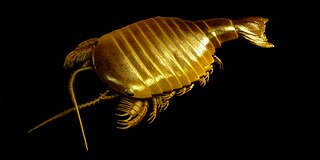 W
WSidneyia is an extinct arthropod known from fossils found from the Early Cambrian-age Maotianshan Shales to the Mid Cambrian Burgess Shale formation of British Columbia. 144 specimens of Sidneyia are known from the Greater Phyllopod bed, where they comprise 0.27% of the community.
 W
WSkeemella clavula is an elongate animal from what is now the Middle Cambrian Wheeler Shale lagerstätte, of Utah. It has been classified with the vetulicolians. The genus shows typical vetulicolian features, such as a body divided into two distinct parts: a wider torpedo-shaped front end and a segmented rear section interpreted as the muscular driver for an active swimming lifestyle. Vetulicolians were originally described as relatives of arthropods, but their classification is debated; the discovery of new genera with a row of front-section openings interpreted as gill slits has shifted their interpretation to stem deuterostomes related to tunicates, or perhaps even crown-group chordates. Newer reconstructions of vetulicolians often resemble tunicate larvae or simple cephalochordates, with the front section as a pharynx used for breathing and ramjet style filter-feeding and the rear section as muscle blocks. However, Skeemella is an unlikely candidate for this interpretation; the rear section segments bear clear affinities to arthropods Either Skeemella is not a vetulicolian, researchers do not yet have enough data to correctly interpret Skeemella, or vetulicolians are not deuterosomes.
 W
WTuzoia is an extinct genus of large bivalved arthropod known from Early to Middle Cambrian marine environments in what is now the Burgess Shale, Emu Bay Shale (Australia), Kaili, the Rockslide Formation, the Spence Shale, Wheeler Formation, and Marjum Formation (Utah), and the Kinzers Formation (Pennsylvania). This arthropod reached lengths of 180 mm long. There are currently 7 valid species recognized.
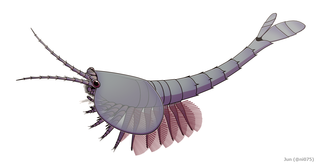 W
WWaptia fieldensis is an extinct species of arthropod from the Middle Cambrian Burgess Shale Lagerstätte of Canada. It grew to a length of about 8 cm (3 in) and resembled modern shrimp in both morphology and habit. It had a large bivalved carapace and a segmented body terminating into a pair of tail flaps. It was an active swimmer, feeding on organic particles it gathered from the seafloor substrate. It is also one of the oldest animals with direct evidence of brood care.
 W
WWiwaxia is a genus of soft-bodied animals that were covered in carbonaceous scales and spines that protected it from predators. Wiwaxia fossils – mainly isolated scales, but sometimes complete, articulated fossils – are known from early Cambrian and middle Cambrian fossil deposits across the globe. The living animal would have measured up to 5 cm (2 inch) when fully grown, although a range of juvenile specimens are known, the smallest being 2 millimetres (0.079 in) long.